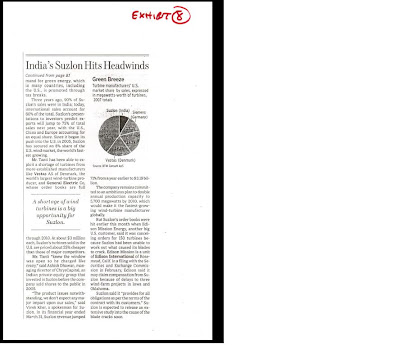CATASTROPHIC TURBINE FAILURE AT VERMONT WIND FARM
RAISES DOUBT ABOUT TURBINE SAFETY, LONGEVITY
NEW HAMPSHIRE (October 16, 2008). Turbine #10 at the Searsburg wind energy facility in Searsburg, Vermont experienced a catastrophic failure when one of the blades came in contact with the turbine’s tower causing it to buckle during high winds. This turbine’s 28-ton nacelle and 3-blade rotor assembly crashed to the ground scattering debris several hundred feet from the structure. Approximately 20-gallons of heavy oil spilled from the unit when its fluid reservoirs were damaged. The 11-turbine Searsburg facility was brought online in 1997 and according to preconstruction documents, the Zond Z-P40-FS turbines had an expected lifespan of 30-years[1].
[To see photos, click http://www.windaction.org/
Industrial Wind Action (IWA) Group’s executive director, Lisa Linowes, was not surprised by the failure. “The Searsburg towers are located at an elevation of nearly 3000-feet in some of the harshest weather conditions in New England. Performance issues and blade failures have plagued this project for some time, “ she said pointing to incidences in May 2006[2] and again in May 2008[3].
While the eleven-year old Searsburg turbines are failing, newer models have not improved the safety record. “Wind developers today tout life expectancies of industrial wind turbines that exceed 20 years,” Linowes said, “but the fact remains that estimates of the functional lifespan of modern utility-scale wind turbines are speculative and cannot be substantiated since so far very few have been operating for ten years.” Unfortunately, unless a person or property is damaged in a turbine failure, there is no obligation for the owner of an industrial wind turbine to report the incident. Information on the number and types of failures is sparse and poorly reported, and thus this vital data is not adequately incorporated into estimates of turbine longevity. The Searsburg failure occurred on September 15th.
“What’s more ominous," Linowes said, “is that reports of turbine failures in the United States are increasing. These failures include blade throws, oil leaks, fires, and collapse.” IWA attributes the increase in reporting to the fact that the machines are more visible, being erected close to where people live, and also due to the growing interest in wind energy development. In the last year alone, IWA has tracked catastrophic failures in Idaho, Minnesota, California, New York, Pennsylvania and elsewhere, raising concerns about public safety.
While weather conditions and climate are taking a toll on the machines, reports from the industry indicate the rush to erect industrial wind turbines is being accomplished at the expense of quality assurance and safe installation practices. Business Week published a report[4] in August 2007, which found, “The facilities may not be as reliable and durable as producers claim. Indeed, with thousands of mishaps, breakdowns and accidents having been reported in recent years, the difficulties seem to be mounting.” A report this year found that turbine owners were not conducting regularly scheduled maintenance necessary to ensure the mechanical towers remain in good operating condition. An informal survey of approximately seventy-five wind farm operators in the United States found as many as sixty-percent were behind in their maintenance procedures[5].
“Public safety should be paramount when siting industrial wind turbines,” Linowes said, adding “there’s a perception that the 400-foot structures can safely be erected merely a few hundred feet from property lines, public areas and rights-of-way.” She pointed to a private high school in Massachusetts[6] as an example where a massive turbine was installed just feet from the school’s driveway. Barrington, Rhode Island is deliberating on the location of an even larger turbine that will stand within 200-feet of the public high school building[7], although that turbine might be relocated in response to parents and residents raising concerns over noise and safety. In both cases, the turbines exceed the size of the destroyed Searsburg tower.
Manufacturers recommend a safety zone with a radius of at least 1300 feet from a wind turbine, and that children be prohibited from standing or playing near the structures[8]. “Green energy should not override common sense,” Linowes said.
-----------
About IWA: Industrial Wind Action Group seeks to promote knowledge and raise awareness of the risks and damaging environmental impacts of industrial wind energy development. Information and analysis on the subject is available through its website, www.windaction.org. To subscribe to the IWA weekly newsletter, visit http://www.windaction.org/
###
[1] Green Mountain Power wind power project development, http://www.windaction.org/?
[2] http://www.windaction.org/
[3] http://www.windaction.org/
[4] The dangers of wind power, http://www.windaction.org/
[5] Maintaining the wind turbine revolution, http://www.windaction.org/
[6] School’s wind turbine rises 262 feet, http://www.windaction.org/
[7] Barrington school committee delays vote on wind turbine, http://www.windaction.org/
[8] Vestas mechanical operating and maintenance manual V90-3.0MW turbine















